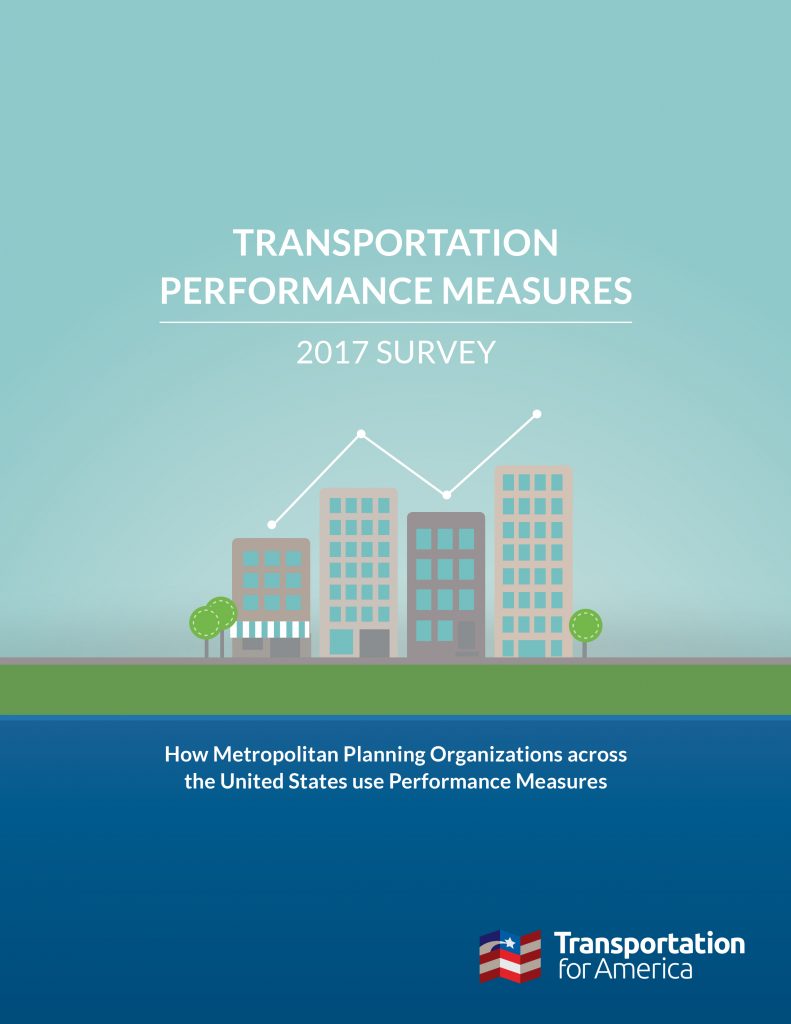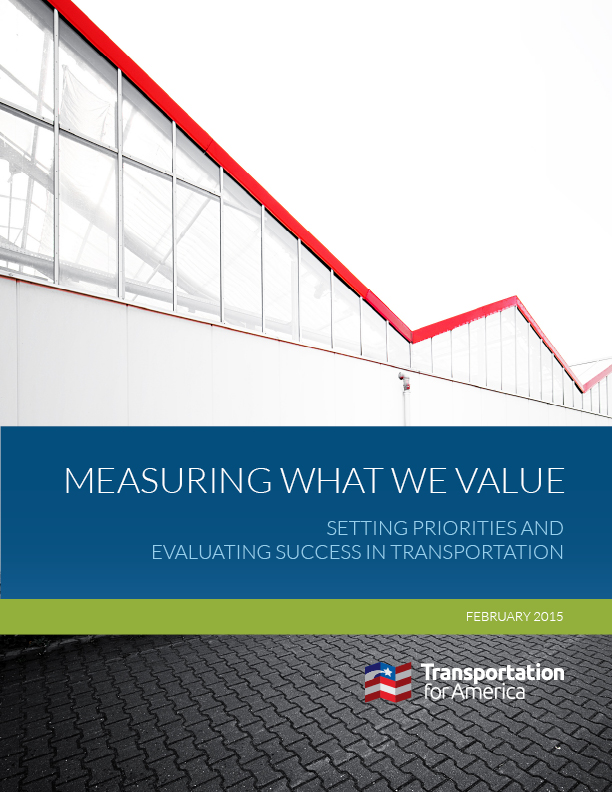MPO Survey on Performance Measures
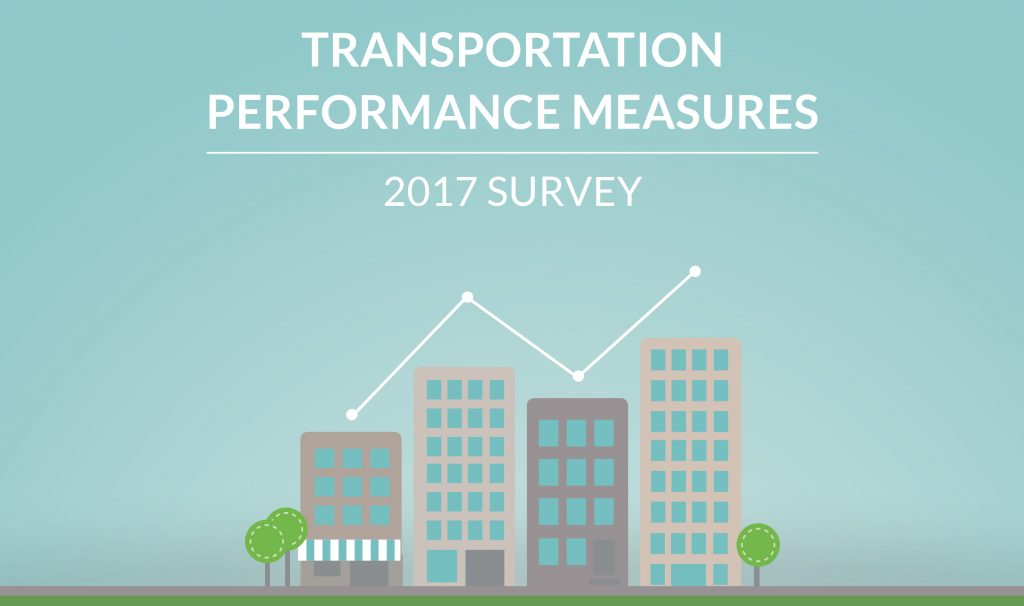
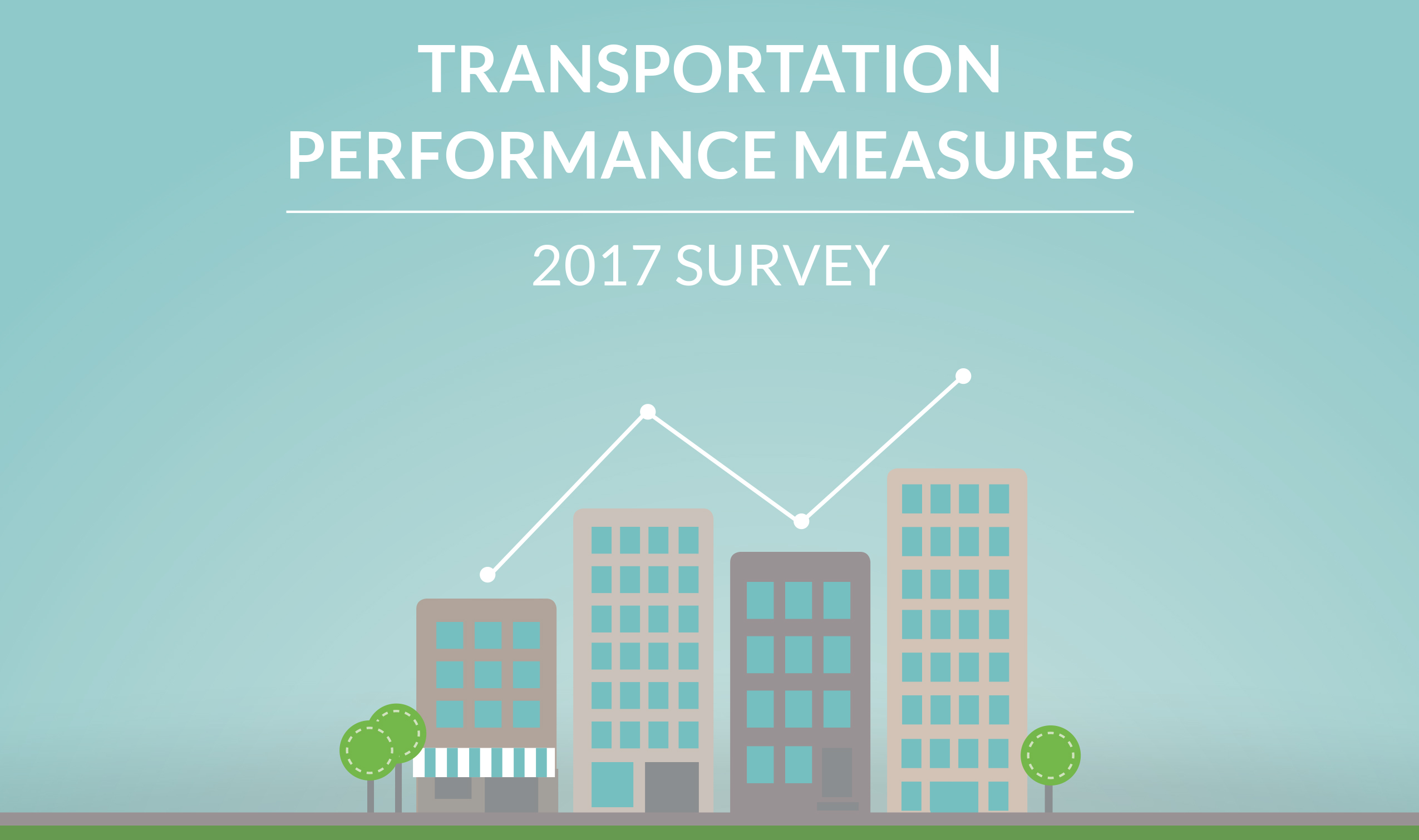
Performance measures for transportation are coming, one way or another, thanks to new federal requirements created by Congress in MAP-21, the federal transportation law enacted in 2012. That law ushered in a new era by requiring metropolitan planning organizations (MPOs) to start evaluating the performance of their transportation investments against a handful of federally required measures.
Some metro areas have been doing this for years, going far beyond the federal government’s modest new requirements (such as safety or condition of roads & bridges) to assess their transportation investments in terms of more ambitious goals like return on investment, public health and access to jobs. With the new suite of measures finalized by USDOT in early 2017, it’s no longer an option for MPOs now — it’s a requirement.
To find the answers to some of these key questions and establish a state of the practice, T4America conducted a national survey of 104 MPOs from 42 states in 2016.
- How many MPOs are already using performance measures in some form?
- How many are interested in going beyond the new modest federal measures?
- What’s keeping them from doing more?
- What other key goals and metrics are they interested in measuring?
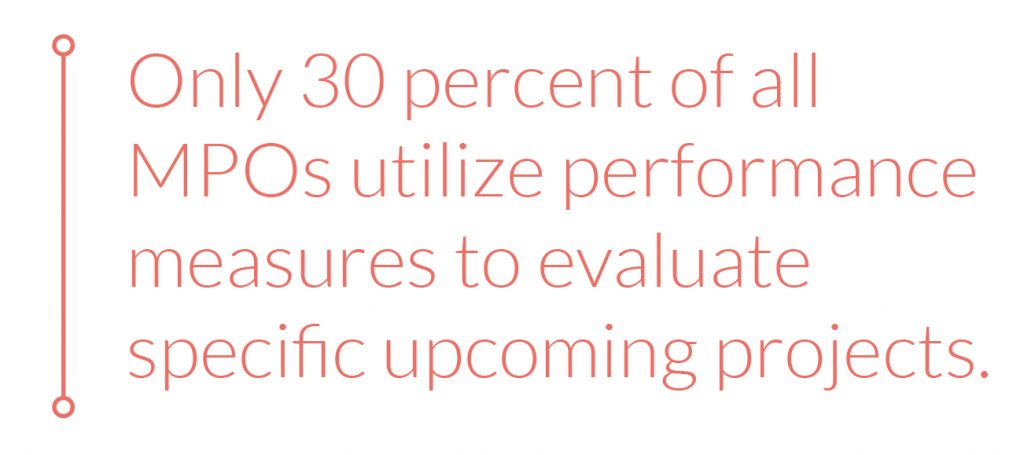 Among a range of interesting findings, we discovered that the majority of the MPOs surveyed (75 percent) are already using performance measures in some fashion. However, there is significant room for improvement in how they use them — only 30 percent of all MPOs utilize performance measures to evaluate specific projects for inclusion in the fiscally constrained five-year plans that govern all short-term spending.
Among a range of interesting findings, we discovered that the majority of the MPOs surveyed (75 percent) are already using performance measures in some fashion. However, there is significant room for improvement in how they use them — only 30 percent of all MPOs utilize performance measures to evaluate specific projects for inclusion in the fiscally constrained five-year plans that govern all short-term spending.
While most MPOs are focused on meeting the new federal requirements, two-thirds of all agencies surveyed also want to become national leaders in using performance measures — including many MPOs currently doing only the minimum or just getting started. When it comes to additional measures outside of MAP-21’s modest new requirements, nearly half of MPOs surveyed chose equity and/or health as one of the five additional goals they are interested in measuring and assessing.

Are MPOs using performance measures?
Performance measures have tremendous power not only to better prioritize investment, but also to build the trust of taxpayers by increasing transparency and accountability. More confidence that existing money is being spent well can help make the case to voters for additional revenue. Overall, transportation planning was already becoming more data-driven, but these new federal requirements mark a shift from the old era to the new. With MPOs required to start implementing these new federal measures, are they ready? How do they use performance measures now? How many are ahead of the curve?
1. Most, but not all, MPOs are currently using performance measures in some fashion. Only 25 percent of MPOs surveyed (26 out of 104) did not use performance measures at all in either their last long-range or constrained short-term planning documents. (The Long Range Transportation Plan or State Transportation Improvement Program/Transportation Improvement Program.
2. Both large and small metro areas are sitting on the sidelines, suggesting that size or capacity aren’t the only reasons MPOs don’t use performance measurement. It’s a common perception that the only MPOs not using performance measures are small ones due to a lack of resources or expertise. Yet 50 percent of the MPOs that did not use performance measures in their last LRTP/TIP were in areas of at least 500,000 in population. This suggests that other factors like organizational culture, preference, governance or the influence of an MPO’s board may be involved.
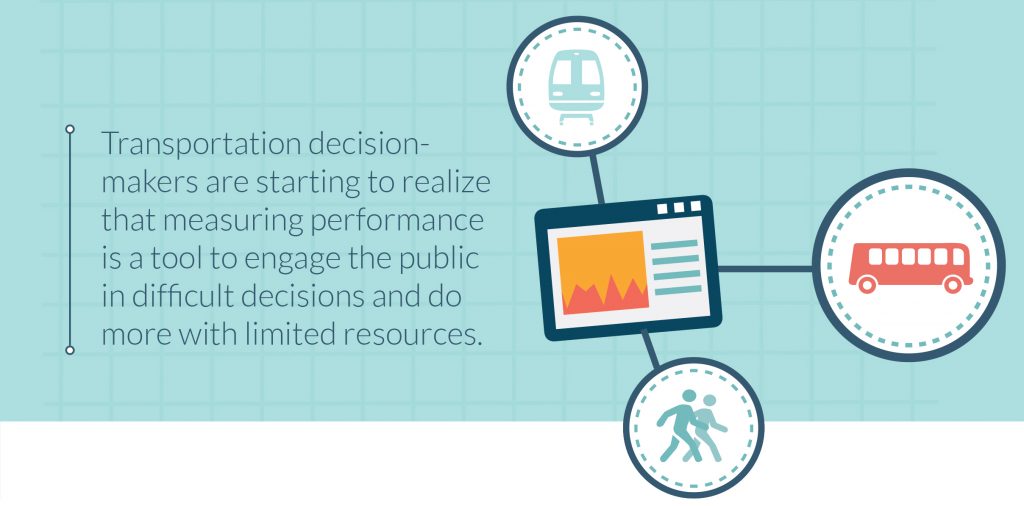
How are MPOs using performance measures?
There are many different ways to develop and implement performance measures, and our survey found significant variation in how MPOs currently apply them. As expected, most are focused on the new federal measures, rolling out over the course of 2017. But there’s significant room for improvement in actually using measures to determine which projects to build to help them meet their goals.
1. MPOs are most focused on the new limited range of measures required by MAP-21. When asked about the five specific areas MPOs would be most interested in exploring out of ten available options in the survey, MPOs chose (in order of preference) 1) transportation safety, 2) transportation system performance, 3) economic growth and competiveness, 4) access to jobs and opportunity and 5) freight movement — most of which are included in some fashion in the just-released final requirements from USDOT that were created by the 2012 MAP-21 legislation.
2. Performance measures are most often used for broader, big-picture, long-range planning, and far less for evaluating specific projects. While 75 percent of the MPOs surveyed (78 of 104) used performance measures in some fashion in their last long-range plan, only 45 of those 78 did so to explicitly select which projects to include. And only 32 of those 78 went a step further to also use measures to influence which specific projects are chosen for inclusion in the five-year plans that govern all short-term spending.
3. MPOs are more likely to use performance measures to evaluate current conditions — less likely to use them for selecting which projects to fund to improve those conditions. 65 of those 78 MPOs that use performance measures said they use performance measures to evaluate current conditions and needs, yet as the previous point shows, a much smaller percentage of MPOs are also using them to choose projects for their long-range planning documents or their more binding short-term project lists.
What keeps MPOs from doing more with performance measures?
There’s a real chicken and egg problem when it comes to performance-based decision-making. The survey shows that the vast majority of MPOs want to implement or strengthen their performance measures and become more data-driven, but they cite the lack of data as one of the biggest barriers to making progress.
1. Data is the most significant barrier to using performance measures. 64 out of 104 MPOs surveyed said that data was the #1 obstacle preventing them from expanding the use of performance measures. The other most significant barriers cited (MPOs could choose three) were inadequate staff/resources (40 votes) and lack of technical tools available (30 votes.)
2. Neither the public nor local elected officials are seen as barriers to using performance measures. Of the ten possible barriers to implementing more performance measurement that could be selected, “resistance from the public,” (3 votes) and “insufficient support from elected officials” (8 votes) received the fewest votes. Using more performance measures is typically an idea that has broad support from the public, which wants to a) see more transparency in decision-making overall and b) know that there’s a system for evaluating whether the dollars spent are accomplishing tangible goals for the traveling public.
Some of these beliefs about data scarcity may be more perception than reality. The regional agencies that participated in a pilot program profiled in our 2015 report on performance measures found that most of their work could be done with existing data, often through the use of data from other agencies or private companies that offer GPS or cell phone data. Taken in concert with the other findings in the survey, it may be that institutional and organizational obstacles — not technical ones — truly pose the largest barrier to performance-based decision-making.

How would MPOs like to expand their use of performance measures?
The survey showed that MPOs want to aggressively develop and implement performance measures and use new metrics that go above and beyond the new modest federal requirements. Transportation decision-makers know better than anyone that funding is limited, and more of them are starting to realize that measuring performance is a tool to engage the public in these difficult decisions and do more with their limited resources. It’s also a way to create partnerships that can help identify priorities and build confidence in the idea of raising and investing more money in the system.
1. The majority of MPOs — even many currently doing just the minimum — are extremely interested in becoming national leaders in performance measures. The overwhelming number of those surveyed (69 of 104) want to go far beyond the modest measures required by MAP-21 — only 7 of 104 MPOs surveyed said they would be interested in meeting just the low bar of the MAP-21 statutory requirements.
2. Numerous MPOs are interested in looking beyond the modest requirements being finalized in 2017. While the survey shows that MPOs are understandably focused on traditional areas for performance measures like system performance and condition (in part to satisfy new federal requirements), MPOs are also interested in going beyond and measuring other outcomes-based areas like economic competitiveness, health, access to opportunity, equity and quality of life measures. Nearly half of MPOs surveyed chose equity and/or health as one of the five areas they are interested in exploring (13 voted for social equity, 13 voted for health, and 19 voted for both out of 104 MPOs).
More on performance measures
Download and read our 2015 primer on performance measures that looked at the innovative DOTs and MPOs experiencing early successes in measuring the performance of their transportation system, with some recommended goals and measures. Read more.




